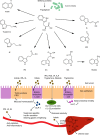Microbial tryptophan catabolites in health and disease
- PMID: 30120222
- PMCID: PMC6098093
- DOI: 10.1038/s41467-018-05470-4
Microbial tryptophan catabolites in health and disease
Abstract
Accumulating evidence implicates metabolites produced by gut microbes as crucial mediators of diet-induced host-microbial cross-talk. Here, we review emerging data suggesting that microbial tryptophan catabolites resulting from proteolysis are influencing host health. These metabolites are suggested to activate the immune system through binding to the aryl hydrocarbon receptor (AHR), enhance the intestinal epithelial barrier, stimulate gastrointestinal motility, as well as secretion of gut hormones, exert anti-inflammatory, anti-oxidative or toxic effects in systemic circulation, and putatively modulate gut microbial composition. Tryptophan catabolites thus affect various physiological processes and may contribute to intestinal and systemic homeostasis in health and disease.
Conflict of interest statement
The authors declare no competing interests.
Figures



Similar articles
-
Impact of Bacterial Metabolites on Gut Barrier Function and Host Immunity: A Focus on Bacterial Metabolism and Its Relevance for Intestinal Inflammation.Front Immunol. 2021 May 26;12:658354. doi: 10.3389/fimmu.2021.658354. eCollection 2021. Front Immunol. 2021. PMID: 34122415 Free PMC article. Review.
-
The aryl hydrocarbon receptor as a mediator of host-microbiota interplay.Gut Microbes. 2020 Nov 9;12(1):1859812. doi: 10.1080/19490976.2020.1859812. Epub 2020 Dec 17. Gut Microbes. 2020. PMID: 33382356 Free PMC article. Review.
-
Gut Microbial Catabolites of Tryptophan Are Ligands and Agonists of the Aryl Hydrocarbon Receptor: A Detailed Characterization.Int J Mol Sci. 2020 Apr 9;21(7):2614. doi: 10.3390/ijms21072614. Int J Mol Sci. 2020. PMID: 32283770 Free PMC article.
-
Berberine improves colitis by triggering AhR activation by microbial tryptophan catabolites.Pharmacol Res. 2021 Feb;164:105358. doi: 10.1016/j.phrs.2020.105358. Epub 2020 Dec 4. Pharmacol Res. 2021. PMID: 33285228
-
Microbial-Derived Tryptophan Catabolites, Kidney Disease and Gut Inflammation.Toxins (Basel). 2022 Sep 18;14(9):645. doi: 10.3390/toxins14090645. Toxins (Basel). 2022. PMID: 36136583 Free PMC article. Review.
Cited by
-
Molecular mechanisms and therapeutic significance of Tryptophan Metabolism and signaling in cancer.Mol Cancer. 2024 Oct 30;23(1):241. doi: 10.1186/s12943-024-02164-y. Mol Cancer. 2024. PMID: 39472902 Free PMC article. Review.
-
Mechanisms of microbe-mediated immune development in the context of antibiotics and asthma.Front Allergy. 2024 Oct 14;5:1469426. doi: 10.3389/falgy.2024.1469426. eCollection 2024. Front Allergy. 2024. PMID: 39469482 Free PMC article. Review.
-
Indole-3-Acetic Acid Esterified with Waxy, Normal, and High-Amylose Maize Starches: Comparative Study on Colon-Targeted Delivery and Intestinal Health Impact.Nutrients. 2024 Oct 11;16(20):3446. doi: 10.3390/nu16203446. Nutrients. 2024. PMID: 39458442 Free PMC article.
-
Bifidogenic Effect of Human Milk Oligosaccharides on Pediatric IBD Fecal Microbiota.Microorganisms. 2024 Sep 30;12(10):1977. doi: 10.3390/microorganisms12101977. Microorganisms. 2024. PMID: 39458287 Free PMC article.
-
Low-Molecular-Weight Compounds Produced by the Intestinal Microbiota and Cardiovascular Disease.Int J Mol Sci. 2024 Sep 27;25(19):10397. doi: 10.3390/ijms251910397. Int J Mol Sci. 2024. PMID: 39408727 Free PMC article. Review.
References
Publication types
MeSH terms
Substances
LinkOut - more resources
Full Text Sources
Other Literature Sources

